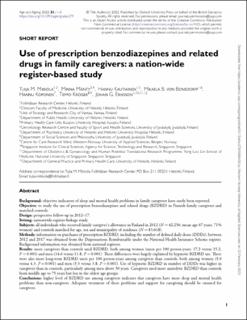| dc.contributor.author | Mikkola, Tuija M. | |
| dc.contributor.author | Mänty, Minna | |
| dc.contributor.author | Kautiainen, Hannu | |
| dc.contributor.author | von Bonsdorff, Mikaela B. | |
| dc.contributor.author | Koponen, Hannu | |
| dc.contributor.author | Kröger, Teppo Kalevi | |
| dc.contributor.author | Eriksson, Johan G. | |
| dc.date.accessioned | 2023-03-24T09:48:26Z | |
| dc.date.available | 2023-03-24T09:48:26Z | |
| dc.date.created | 2023-01-09T10:45:46Z | |
| dc.date.issued | 2022 | |
| dc.identifier.citation | Age and Ageing. 2022, 51 (12), . | en_US |
| dc.identifier.issn | 0002-0729 | |
| dc.identifier.uri | https://hdl.handle.net/11250/3060271 | |
| dc.description.abstract | Background
objective indicators of sleep and mental health problems in family caregivers have rarely been reported.
Objective
to study the use of prescription benzodiazepines and related drugs (BZDRD) in Finnish family caregivers and matched controls.
Design
prospective follow-up in 2012–17.
Setting
nationwide register-linkage study.
Subjects
all individuals who received family caregiver’s allowance in Finland in 2012 (N = 42,256; mean age 67 years; 71% women) and controls matched for age, sex and municipality of residence (N = 83,618).
Methods
information on purchases of prescription BZDRD, including the number of defined daily doses (DDDs), between 2012 and 2017 was obtained from the Dispensations Reimbursable under the National Health Insurance Scheme register. Background information was obtained from national registers.
Results
more caregivers than controls used BZDRD, both among women (users per 100 person-years: 17.2 versus 15.2, P < 0.001) and men (14.6 versus 11.8, P < 0.001). These differences were largely explained by hypnotic BZDRD use. There were also more long-term BZDRD users per 100 person-years among caregivers than controls, both among women (5.0 versus 4.3, P = 0.001) and men (5.3 versus 3.8, P < 0.001). Use of hypnotic BZDRD in number of DDDs was higher in caregivers than in controls, particularly among men above 50 years. Caregivers used more anxiolytic BZDRD than controls from middle age to 75 years but less in the oldest age groups.
Conclusions
higher level of BZDRD use among caregivers indicates that caregivers have more sleep and mental health problems than non-caregivers. Adequate treatment of these problems and support for caregiving should be ensured for caregivers. | en_US |
| dc.language.iso | eng | en_US |
| dc.rights | Navngivelse-Ikkekommersiell 4.0 Internasjonal | * |
| dc.rights.uri | http://creativecommons.org/licenses/by-nc/4.0/deed.no | * |
| dc.title | Use of prescription benzodiazepines and related drugs in family caregivers: a nation-wide register-based study | en_US |
| dc.type | Peer reviewed | en_US |
| dc.type | Journal article | en_US |
| dc.description.version | publishedVersion | en_US |
| dc.rights.holder | © The Author(s) 2022 | en_US |
| dc.source.pagenumber | 5 | en_US |
| dc.source.volume | 51 | en_US |
| dc.source.journal | Age and Ageing | en_US |
| dc.source.issue | 12 | en_US |
| dc.identifier.doi | 10.1093/ageing/afac279 | |
| dc.identifier.cristin | 2103069 | |
| cristin.ispublished | true | |
| cristin.fulltext | original | |
| cristin.qualitycode | 2 | |

